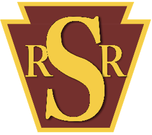Education - Part 3D2
Track Laying
Track Laying
Once track foundation, drainage and ballast have been laid down (usually by earth-moving equipment), track can be laid. Today this is done by track-laying equipment. There are two basic approaches to mechanized track laying. In one, ballast, prestressed concrete or steel ties and rails are brought to the construction site on the track-laying machine and assembled as the machine travels along the newly-laid track. In the other, track sections (rails, ties and all) are fabricated in factories designed for this work. The sections are then loaded on railroad cars for transport to the site where they are put in place. Special sections of track, such as turnouts and crossovers (see Track Configurations) are usually fabricated before transport to the installation site. However, when a section is too large to transport by rail, it is assembled on site.
The best way to understand mechanized track laying is to watch a video, such as this one of a track-laying machine (7.3 minutes). In this video, the machine is rebuilding a high-speed railroad track, replacing the older prestressed concrete ties (which are stored somewhere on the machine), leveling the ballast, placing new ties and eventually laying the rails, welding the newly-laid rails to those already in place (producing continuous welded rail or CWR), tamping the new rails and then rolling onto them for the next section. Another video further helps to understand machine-installed track (17.5 minutes).
Installation and maintenance of trackage is now heavily mechanized, compared with former methods, thus reducing time required and improving both accuracy and safety. We will have more to say about maintenance later.
Once track foundation, drainage and ballast have been laid down (usually by earth-moving equipment), track can be laid. Today this is done by track-laying equipment. There are two basic approaches to mechanized track laying. In one, ballast, prestressed concrete or steel ties and rails are brought to the construction site on the track-laying machine and assembled as the machine travels along the newly-laid track. In the other, track sections (rails, ties and all) are fabricated in factories designed for this work. The sections are then loaded on railroad cars for transport to the site where they are put in place. Special sections of track, such as turnouts and crossovers (see Track Configurations) are usually fabricated before transport to the installation site. However, when a section is too large to transport by rail, it is assembled on site.
The best way to understand mechanized track laying is to watch a video, such as this one of a track-laying machine (7.3 minutes). In this video, the machine is rebuilding a high-speed railroad track, replacing the older prestressed concrete ties (which are stored somewhere on the machine), leveling the ballast, placing new ties and eventually laying the rails, welding the newly-laid rails to those already in place (producing continuous welded rail or CWR), tamping the new rails and then rolling onto them for the next section. Another video further helps to understand machine-installed track (17.5 minutes).
Installation and maintenance of trackage is now heavily mechanized, compared with former methods, thus reducing time required and improving both accuracy and safety. We will have more to say about maintenance later.

